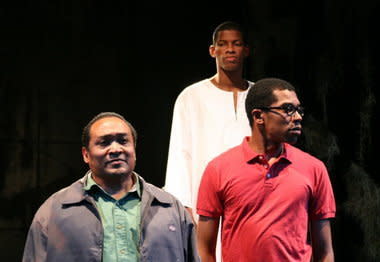Review: Brother/Sister Plays Part II

Bobby Bermea, Damian Thompson, and Brian Demar Jones take lead roles in Portland Playhouse’s multigenerational masterpiece.
Here’s what you need to know about Portland Playhouse ‘s Brother/Sister Series: You won’t get the second part without seeing the first part, and you might not get the first part, either, without reading up. The first part is one play, while the second part is two plays, and the whole series is a two-part trilogy (yes, you read that correctly) across a multigenerational timeline. Moreover, symbols abound, connections are complex, and the narrative splits and rejoins in places you wouldn’t anticipate.
In fact, the series is so complicated that there’s a wall chart posted in the theater to delineate it, complete with codes for the three plays (“RBW” = "In The Red and Brown Water, and so on) and strings between characters bearing details of interpersonal connection (lover, child, etc). With so much study implicit in one’s appreciation, prodigy playwright Tarell Alvin McCraney’s work seems to reverse the usual literature-to-theater path, creating characters that instead leap from the stage onto the page.
As if to help their theoretical transcriber, the play’s characters self-narrate their actions in third person before demonstrating them. “Shaunta kisses her teeth,” says Shaunta (Lava Alapa’i), making a sucking sound. “Oshoosi Size smiles,” says Oshoosi (Damian Thompson), smiling. As a watcher, you’re caught off guard by the synesthesia of seeming to read what you’re actually physically seeing, and this sort of sensory confusion is the hallmark of another discipline: hypnosis.
As a piece of literature, the series could be shelved between the heady, epic complexity of John Updike’s In The Beauty of the Lilies and the black-vernacular slang poetry and close-knit community of Zora Neal Hurston’s Their Eyes Were Watching God. As a hypnotic induction, it flows alongside the conventions established by “father of hypnosis” Milton Erickson. Repetition, in this case of dreamlike and mutable motifs (water, deity presences, the moon and other universal icons), gesture (the “God poses” that characters repeatedly assume, especially in RBW), and sound (intermittent djembe drumbeats) gradually ply the audience open to pleasant disorientation and strong suggestibility—that is to say, you will have the intended experience, but once you snap out of your trance, you may be unable to remember or explain it.
Part I , In the Red and Brown Water, was reviewed last week by Aaron Scott .
Part II
The Brothers Size is perhaps the most traditional narrative of the three, a classic Cain-and-Able tale with a few personalizing details. Oshoosi (Damian Thompson) has been released from prison into the care of his salt-of-the-earth older brother, auto mechanic Ogun (Bobby Bermea). While Ogun tries to reform his younger brother, Oshoosi’s presumed prison lover Legba (Brian Demar Jones) tries to draw him back into the system. In what turns out to be a furlough rather than a fresh start, Ogun and Oshoosi wrestle, tease each other and even spring into an ardent performance of Otis Redding’s “Try a Little Tenderness,” as Ogun confesses that he’s always looked out for his little bro, and Oshoosi admits that yeah, he knows. Ogun and Legba are both carryover characters from RBW, in which Ogun was the longsuffering boyfriend of the charming but ineffable Oya, and little Elegba was a mysterious kid who haunted everyone’s lawn, manifested a foreshadowing sweet tooth (more on that later) and reported having strange dreams and visions.
Marcus; Or The Secret of Sweet, follows Legba’s legacy to a son, Marcus, who shares many of his father’s traits—most notably, being “sweet” (a black vernacular term for “gay,” and a variance of the common idiom “He’s got sugar in his back pocket.”) To cement their similarity, the roles of both father and son are played by the same actor: Brian Demar Jones. On the surface it’s a coming-out tale, but in the context of all three plays, perhaps it’s also a more profound demonstration of the general repetition of sociological cycles, with a note of hope about each new generation’s increased potential for crisis coping and self-actualization.
Marcus, it seems, finds a healthier outlet for his sexual preferences than his father did. Similarly, a group of young girls (played by the same cast members who portrayed the prior generation of women in RBW) seems more resilient and supportive than their foremothers, especially in the case of Osha (Ramona Lisa), Marcus’s would-be girlfriend, who’s slighted by his announcement but not brokenhearted. “I shoulda known,” she quips. “You the only one I can sing The Wiz straight through with.” Where Oya (also played by Ramona Lisa) was ultimately crushed by a failed romance while the women around her acted resentful and catty, these new characters from the next generation, far more self-possessed, take romantic disappointments in stride.
Though all portrayals are strong and many performances are more flamboyant, the unlikely keynote of the trilogy turns out to be shy, stuttering straight-man Ogun (Bobby Bermea, artistic director of Portland’s BaseRoots Theater). As the only character who appears in all three pieces, Bermea’s role becomes a stable center point around which the rest of the action hypnotically unfurls.
Like a good book, the Brother/Sister series demands an investment of time, energy, analysis and emotions in exchange for a journey into worlds you might not have otherwise seen, and lives you haven’t lived. Unlike a book, it’s only open for a limited time…so get cracking.
For more about Portland arts, visit PoMo’s Arts & Entertainment Calendar, stream content with an RSS feed, or sign up for our weekly On The Town Newsletter!
